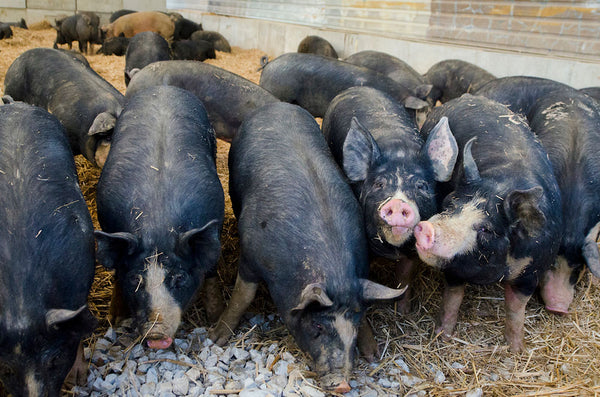
An Intro to Heritage Pork Breeds
The core of Heritage Foods USA’s mission is to preserve rare heritage breeds. We work hard to support family farms that raise their animals on natural diets and without the aid of antibiotics, which are common on industrial farms.
Heritage pork is sourced from Certified Humane Red Wattle or Six-Spotted Berkshire stock. Some of our farmers, however, also raise other rare breeds – Duroc, Old Spot, Large Black, and Tamworth – which are available for purchase by request, or as porterhouse chops and cured hams.
Berkshire meat is elegant, luscious and smooth. The streaks of fat that run through Berkshire meat produces a round, buttery flavor that melts on the tongue. The firm and substantial texture of Berkshire meat was so cherished by the British monarchy that they exported the breed as far as Japan, where it is called Korobuta.
As seen above, the Red Wattle is the only pig left in the world that still has a wattle hanging from its jowl. Red Wattle meat is charmingly inconsistent; its expressive porky flavor is concentrated and even a little racy. Originating in the South Pacific, the Red Wattle pig populated the backyards of New Orleans during the 18th and 19th centuries where it was bred to stand up to the strong and flavorful Creole cuisine. These gentle red hogs are renowned foragers: when allowed to roam, their meat develops earthy, herbaceous traces of the vegetation within their locale.
Duroc meat is clean and crisp. Its taste and texture are polished and easy on the palate. Duroc pork is a standard – not too fatty, not too lean, not too strong – but is certainly more flavorful than its factory farmed cousins. In fact, Duroc genetics were used in the foundation of the pig industry, which gained momentum in the 20th century.
Tamworth meat is robust and gutsy, and is the leanest of the heritage pork breeds- making it an excellent source of bacon and jowl. Its balanced flavor is the pork equivalent of a red beer. Despite its presence on the Threatened species list, the Tamworth is a hearty, strong, resilient animal – making it an excellent candidate for the growing urban farm movement around the United States.
Large Black and Gloucestershire Old Spot pigs are listed as critically endangered by the American Livestock Breeds Conservancy. Along with the Red Wattle, they are the rarest pig breeds that Heritage Foods sells.
Originating in the Berkley Vale of Gloucestershire during the 1800s, the GOS was bred to lounge around in the orchards of England, where its sole responsibility was to clean up fallen fruit. The breed became rare after World War II, when the shift to intensive pig production reduced interest in grazing pigs. Due to its supreme laziness, GOS meat is very delicate – even its fat is edible and milky. Old Spots carry a distinct layer of backfat and marbling within their meat, making them the bacon pig of choice for many.
The Large Black is a favorite of farmers who appreciate the breed’s intellect and docility. Its strength, hardiness, and ability to forage make it a valuable asset for pasture-based farming. The breed is native to southwestern England and gained popularity in the 1800’s as farmers began to see that the animal could easily turn poor-quality feed into large quantities of high-quality meat. The Large Black’s physical characteristics – its dark skin and large ears – make it stand out in terms of appearance and efficiency: its dark skin protects it from sunburn during long hours of grazing, and its long ears shield its eyes from dirt while foraging. Large Blacks are also known for their lean consistency; however, they lack the excess back fat found in the GOS.
